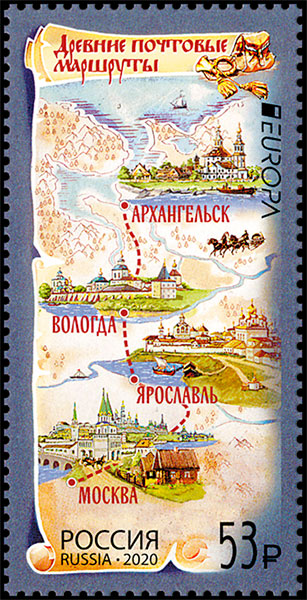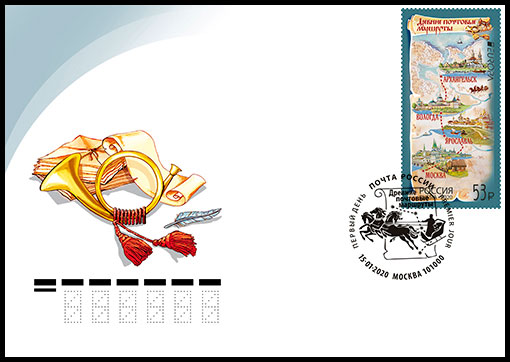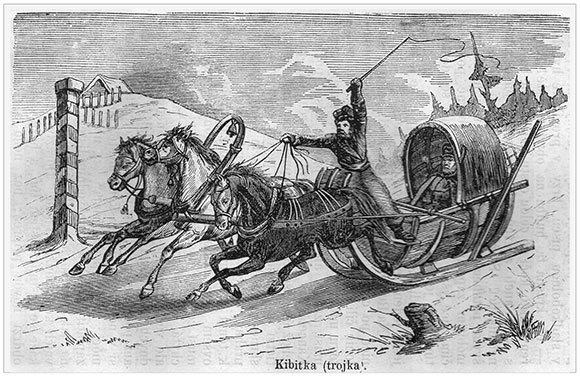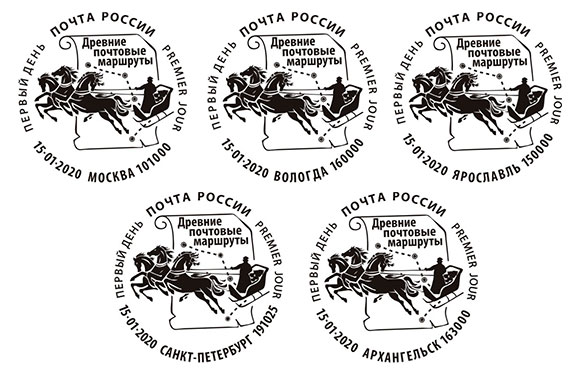
On January 15, 2020, the Russian Post issued a postage stamp as part of the Europe program. This year, Ancient Postal Routes were chosen as the theme for the European issue.
I was personally very pleased with the theme of this year - Ancient Postal Routes, because this allows us to hope for a significant replenishment of the collection with new stamps depicting horses. After all, for many years the main method of delivering mail was fast horse messengers and postal carriages. So, dear friends, we are preparing a place in the albums for new stamps!
I am pleased that this year the Russian stamp became the first stamp with a horse in the "Europe. Ancient Postal Routes" issue. Apparently, our horses ran the fastest.
On a 53 ruble postage stamp, designed by the artist-designer Olga Shushlebina, we see a stylized map with a panorama of ancient cities, between which the Kholmogorsky postal tract runs in a red dotted line.

The Kholmogory postal route was known at the end of the 15th century. It began in Moscow, went through the settlement of the Trinity Monastery, Pereslavl-Zalessky, Rostov the Great, Yaroslavl, Danilov to Vologda. It was there that the first well-mastered segment of the postal route ended. The Kholmogorsky tract has always played an important role in the history of the Russian North, but it acquired special significance at the end of the 17th century. At that time, Arkhangelsk was the only Russian port through which sea trade and communication with European countries was carried out. The first proposals to establish a post office in Arkhangelsk and extend the postal route in Pomorie were made in the middle of the 17th century during the reign of Tsar Alexei Mikhailovich. However, regular mail service between Arkhangelsk and Moscow appeared only in 1693 during the reign of the young Peter I.
On June 8, a decree was announced on the organization from July 1, 1693 of a permanent postal chase between the capital and Pomorie. The decree ordered the organization of post stations (yam) along the entire route from Moscow to Arkhangelsk. At the post stations, horses were kept, there were resting places for coachmen, stables and inns. The postmen's route passed through Pereslavl-Zalessky, Rostov Veliky, Yaroslavl, Danilov, Vologda and further along the Vaga and Northern Dvina rivers through the cities of Velsk, Shenkursk and Kholmogory. Now the federal highway M-8 "Kholmogory" runs along the route of the Kholmogorsky tract, the length of the route from Moscow to Arkhangelsk is 1,226 kilometers.
The organization of the postal service was in charge of the Ambassadorial Prikaz, to which the Russian post was subordinate. What is characteristic of the tsar's decree absolutely accurately determined the speed of mail delivery: in summer and winter, on good roads, mail had to be delivered in 8-9 days, and in muddy roads in spring and autumn in 10-11 days. Even the time of the driver's arrival at the post station was recorded. Moreover, in the royal decrees and orders it was ordered to pay special attention to the safety of postal correspondence. The drivers had to carry letters and letters very carefully, protecting them not only from damage, but even from rain, for the loss or damage of mail the driver was in danger of torture.

The main means of transport for the transportation of mail were post kibitka (russian type of carriage). These were covered carts or sledges, into which three horses were harnessed for speed. It is such a small post wagon that is depicted on a postage stamp on the outskirts of Arkhangelsk. One more horse-drawn carriage can be seen at the exit from Moscow, but due to its small size and not very successful perspective, it is not possible to say something more specific about it.
On January 15, 2020, at the post offices in five cities along the Kholmogorsk post tract: Moscow, Yaroslavl, Vologda, Arkhangelsk and additionally in St. Petersburg, the first day cancellation took place at the same time. A special postmark depicts a coachman driving a troika of horses. The design of the stamp for all cities was the same, they differed only in the name of the settlement and the number of the post office.

Перейти в каталог


